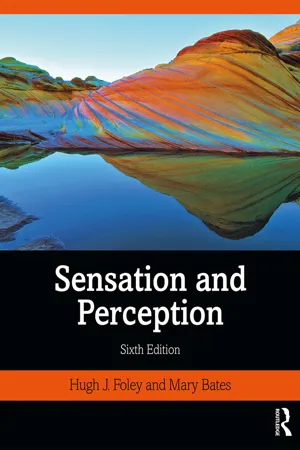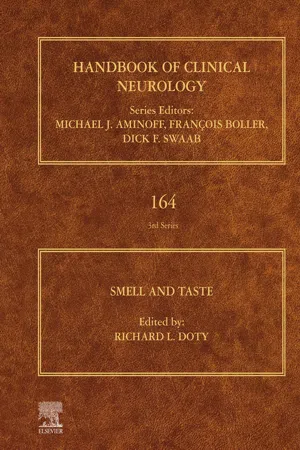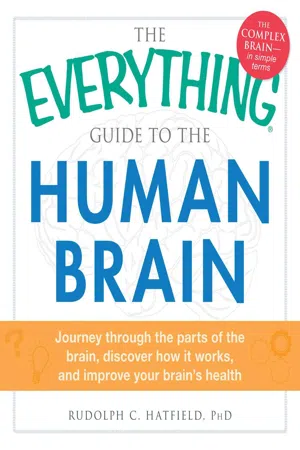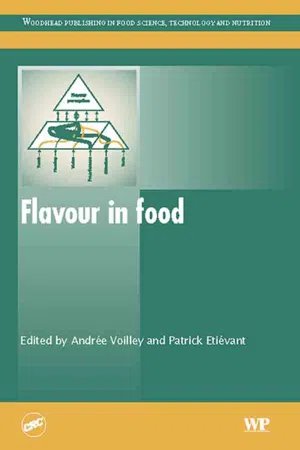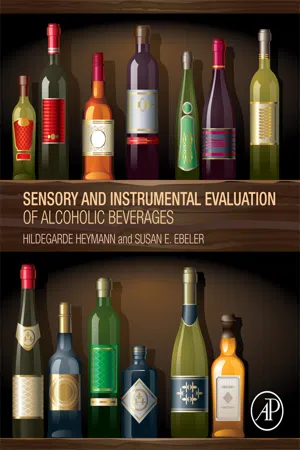Chemical Senses
Chemical senses refer to the sensory systems responsible for detecting and processing chemical stimuli in the environment. This includes the senses of taste and smell, which play a crucial role in our perception of flavors and odors. These senses are closely linked to our emotions, memories, and overall sensory experiences.
7 Key excerpts on "Chemical Senses"
- eBook - ePub
- Hugh Foley, Margaret Matlin(Authors)
- 2015(Publication Date)
- Psychology Press(Publisher)
...Furthermore, different people may perceive the identical stimulus as different. Use the Chemical Senses to provide further examples of the disparity between the physical stimulus and perceptual experience. What are the important characteristics of stimuli that determine whether they are odorous? Suppose you sniff an orange and a lemon, and they smell similar. How would Henning’s and Amoore’s systems explain the similarities? In a laboratory at your college, suppose that a professor measures a student’s threshold for a particular odor, and it is high. In a laboratory at another college, a different professor measures a different student’s threshold for a second odor, and it is low. Identify as many factors as possible that might explain the different results. Point out aspects of the following topics that might be relevant for a person who develops perfumes: absolute thresholds, difference thresholds, adaptation, cross-adaptation, odor recognition, and odor constancy. Two portions of this chapter discussed the importance of human body odors—the section on smell recognition and the section on pheromones. Summarize the results of these two sections. How might development of a human sex pheromone alter social interactions? Researchers have made great strides in learning how the chemical sense receptors encode infor mation. They have also learned a great deal about the areas of the brain responsible for encoding the information. Briefly describe these processes, but then illustrate how cognitive processes play an important role in your experience of flavor, taste, and smell. Describe how flavor is a multisensory experience. You should emphasize the Chemical Senses, but also draw on other senses. Use examples from your own life to illustrate these principles where you can. Key Terms Chemical Senses, p. 354 flavor, p. 354 taste, p. 354 tastant, p. 354 papillae, p. 355 taste bud, p. 355 taste receptor cells, p. 355 microvilli, p. 355 taste pore, p. 355 G-proteins, p...
- eBook - ePub
- Hugh J. Foley(Author)
- 2019(Publication Date)
- Routledge(Publisher)
...Chapter 13 The Chemical Senses Taste and Smell Taste Sensory Aspects of Taste Modifying Taste Perception Measuring Taste Perception Individual Differences in Taste Perception Smell Sensory Aspects of Smell Cognitive Aspects of Smell Modifying Olfactory Perception Measuring Olfactory Perception Individual Differences in Olfactory Perception Recognizing and Identifying Odors ● IN-DEPTH Behavioral Influences of Odors Odor Effects on Behavior in Other Animals Odor Effects on Behavior in Humans Flavor: Interaction of Taste, Smell, and Other Senses Contributions of Taste and Smell to Flavor Contributions of Somatosensory Input to Flavor Contributions of Temperature to Flavor Contributions of Vision to Flavor Contributions of Audition to Flavor Contributions of Cognition to Flavor Putting It All Together: Hedonics of Foods Y ou’ve now journeyed through many chapters into which we’ve somewhat arbitrarily separated our discussion of many senses. However, throughout the text (consistent with Theme 1), we’ve pointed out the connections among your senses and the integrated nature of your perceptual experience. Nowhere is the multisensory nature of your experience more obvious than in taste and smell. These two senses are frequently grouped together under the name Chemical Senses because both are sensitive to chemical stimulation. To illustrate the complexity of taste and smell, think of a particularly delicious meal you’ve enjoyed. Now ask yourself what made the food so delicious. One influential aspect of the meal was the flavor of the food. Flavor is a term that includes both taste and smell, as well as tactile experiences (Prescott, 2004 ; Taylor & Hort, 2004). When you say that something tastes good, you are really reflecting its flavor. Thus, you are reporting on stimulation to your nose as much as to your palate. In addition to flavor, visual input (the presentation of the food) was surely important...
- eBook - ePub
- Richard L. Doty(Author)
- 2019(Publication Date)
- Elsevier(Publisher)
...This chapter provides, from a neuroimaging perspective, a comprehensive overview of the anatomy and physiology involved in the odor and taste processing in the central nervous system. Some methodological challenges associated with chemosensory neuroimaging research are discussed. Multisensory integration, the mechanisms that enable holistic sensory experiences, is emphasized. Keywords Olfaction; Gustation; Odor; Flavor; Multisensory integration; Olfactometer; Gustometer; Attention; Reward; Functional imaging Introduction Some of the most precious moments in our lives are brought to us not from the frontiers of the entertainment industry, but via ancient neural networks within the archicortex—networks that developed to secure survival, food intake, and reproduction through their responses to external chemical signals. The smell of a newborn baby or a loved partner, the satisfaction of a perfectly prepared meal, the familiar scent that evokes vivid memories from childhood. Smells and tastes provide a key to our past, both ontogenetically and phylogenetically. They have truly remarkable effects on the perceiver, and they carry important meanings in many different cultural settings and historical epochs (Classen et al., 1994). How does the brain's circuitry accomplish such impressive tasks, and how are smell and taste functions affected by psychiatric and neurological disorders? In this chapter, we show how modern brain imaging techniques have contributed to our understanding of human brain systems for processing sensory information from the smell and taste channels. While neuroimaging techniques have been widely used to explore perception and cognition in the so-called “higher” visual and auditory senses, chemosensory perception of smell and taste has attracted less interest, in part because of practical difficulties in assessment and the fact that fewer researchers are involved in the study of the Chemical Senses...
- eBook - ePub
The Everything Guide to the Human Brain
Journey Through the Parts of the Brain, Discover How It Works, and Improve Your Brain's Health
- Rudolph C Hatfield(Author)
- 2013(Publication Date)
- Everything(Publisher)
...CHAPTER 6 Chemicals in Your Brain: Taste and Smell The first sensory system in animals was probably a chemical sensitivity of some type. Chemical Senses are important in finding food, locating potential mates, and avoiding danger. Although most people would think that vision is the most important sense—in terms of survival value, Chemical Senses have far more to offer for most animals. This chapter reviews the Chemical Senses of taste and smell in humans. How Many Different Tastes Are There? Taste receptors are found on the tongue and in parts of the mouth (oral cavity). These receptors typically occur in groups of approximately fifty, termed taste buds. Taste buds located on the tongue are most often found in the papillae, which are the small protrusions located on the tongue. The average number of taste buds a person has is estimated to be at around 10,000. There is not a one-to-one correspondence between a taste bud and a neuron; the neurons responding to taste buds receive many inputs. You have probably heard at some time or another that there are four or five primary tastes. Typically these primary tastes consist of bitter, salty, sour, and sweet. In some cases meaty (umami) is included as a primary taste. Other newer models of taste include these five primary tastes plus metallic as a primary taste, making the number of basic tastes the tongue can detect as six. Other models extend the number further. Can you taste water? Dogs and pigs, and perhaps some other animals, can taste water, but people cannot. Humans do not actually taste water, even mineral waters. What humans taste are the chemicals or the impurities in the water. While taste receptors interact with smell, this conventional view of taste purports that every taste that humans experience results from the combination of one or more of these primary tastes...
- eBook - ePub
- Andree Voilley, Patrick Etiévant(Authors)
- 2006(Publication Date)
- Woodhead Publishing(Publisher)
...2 Processing information about flavour A. Holley, Centre Européen des Sciences du Goût, France 2.1 Introduction Flavours are chemical sensations elicited by a vast number of molecules released by food during eating. Several sensory systems are involved in flavour detection depending on physicochemical properties of stimulating molecules such as volatility and lipid vs water solubility, along with receptive properties of different detectors present in the nose and oral cavity. Three chemosensory modalities, olfactory, gustatory and trigeminal, contribute to flavour perception. They are distinct regarding their respective biological substrates but are hardly distinguishable in the consumer’s experience. In everyday life, human subjects are generally not aware of the origins of chemical sensations experienced during eating, justifying the use of the global category of ‘flavour’ (‘goût’ in French). Even in experimental conditions, while olfactory and gustatory stimuli can often be accurately distinguished, it is not easy to operate the same clear-cut distinction between trigeminal and both olfactory and gustatory stimuli. While consumers do not confuse the visual image of an aliment and its acoustic properties, why do they fail to distinguish between sensations that are elicited by distinct sensory substrates in the chemical domain? The reason is the existence of multimodal interactions. Some of these interactions occur at a low level, close to the reception stage; others result from the convergence of different sensory messages to one or several common integrative areas, at higher levels in the brain. This chapter is aimed at describing neurobiological substrates of chemosensory perception...
- eBook - ePub
Fundamentals of Children and Young People's Anatomy and Physiology
A Textbook for Nursing and Healthcare Students
- Ian Peate, Elizabeth Gormley-Fleming, Ian Peate, Elizabeth Gormley-Fleming(Authors)
- 2021(Publication Date)
- Wiley-Blackwell(Publisher)
...Chapter 18 The senses Joanne Outteridge School of Nursing and Midwifery, Anglia Ruskin University, Cambridgeshire, UK Aim The aim of this chapter is to discuss the special senses of smell, taste, hearing and sight, exploring how the structures involved receive environmental signals and process these into nerve impulses to be interpreted by the brain. Learning outcomes By the end of this chapter, the reader will be able to: State the anatomical, physiological and neurological requirements for the Chemical Senses of taste and smell. Outline how the anatomy of the ear enables it to perform the functions of both hearing and equilibrium (balance). Discuss how hearing and balance are sensed and translated into neurological signals to be processed by the brain. Recognise and label the anatomical structures of the eye. Explain how the retina processes visual images, and the role of the visual cortex of the brain in receiving and processing those images. Critically analyse how normal growth, development and family functioning are affected when a child or a young person has a hearing or visual disorder. Test your prior knowledge To what do the terms ‘olfaction’ and ‘olfactory’ refer? Where are the taste buds situated? What are the five main tastes that we can process? What is the Eustachian tube, and where is it? What is the organ of Corti responsible for? What are the semicircular canals responsible for? What is the coloured part of the front. of the eye called, and what is its function? What are the rods and cones of the retina? What is your ‘blind spot’? At what age do all children in the United Kingdom have routine visual screening, and why? Introduction The way in which children and young people interact with their environment relies on their senses receiving information, their brains processing that information and then providing either a physical or a culturally appropriate social response to that information...
- Hildegarde Heymann, Susan E. Ebeler(Authors)
- 2016(Publication Date)
- Academic Press(Publisher)
...1 Sensory perception Abstract Flavor perception in alcoholic beverages is the integration of information from the senses of vision, gustation, olfaction, and the somatosensory and trigeminal systems. These senses are complex and each has inherent genetic and phenotypic variability. In this chapter we describe the receptors, transduction, and neurointegration for the aforementioned senses. We also highlight normal human variability and caution sensory practitioners to take these into account when designing sensory studies. Finally, we briefly discuss the effects of multisensory integration due to receptacle, background color and ambient noises of flavor perception. We conclude with the statement that sensory scientists must keep in mind that the senses affect each other. Keywords flavor perception vision gustation olfaction chemesthesis transduction multisensory integration In this chapter 1.1 Vision 1.2 Gustation 1.3 Olfaction 1.4 Chemesthesia 1.5 Flavor References “Flavor is the psychological interpretation of the physiological response to a physical stimulus.” This definition, said to one of us in 1986, by Milton Bailey, a professor of meat flavor at the University of Missouri, has resonated with us ever since. It neatly encapsulates the three entities required to perceive flavor—a human with a functional brain, a working sensory system, and a physical stimulus in the form of chemical compounds. This chapter focuses on the human sensory system and the transduction of information to the brain. We will briefly describe how the sensory systems for vision, olfaction, gustation and chemesthesis work. We will also describe some of the related neurobiology research relevant to each of these systems...

